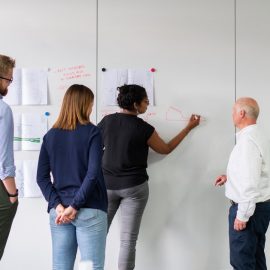

This article is an excerpt from the Shortform book guide to "Where Good Ideas Come From" by Steven Johnson. Shortform has the world's best summaries and analyses of books you should be reading.
Like this article? Sign up for a free trial here.
What drives innovation? Where do new, groundbreaking ideas come from?
According to best-selling author and theorist Steven Johnson, innovation happens when we seek out new ideas and cultivate environments in which fresh ideas can emerge and grow. In Where Good Ideas Come From, he explains the various avenues you should explore to come up with the best ideas.
Read more to learn about the seven goldmines of innovation that Johnson discusses.
Steven Johnson on Innovation
According to Steven Johnson, innovation is largely the result of ideas that come about through social collaboration. For an idea to be good, he says, it must be built upon accumulated knowledge and be put forward at a time when users can conceive of how to use the idea and when the needed resources for the idea are available. Ideas can result from a combination of underlying unfinished ideas fed over time, sudden inspiration, mistakes, and the practice of using other innovations for purposes distinct from their original functions.
Let’s explore each avenue of innovation that Johnson puts forth.
#1: The Adjacent Possible
Platforms of knowledge shape the realm of the adjacent possible. The adjacent possible is a theory developed by Stuart Kauffman that refers to the realm of new ideas that are within reach based on society’s current available information, resources, and abilities. While good ideas can come from outside the adjacent possible, all successfully implemented ideas come from within it.
Ideas developed in the adjacent possible are understandable and achievable at the time they’re created. Those that are developed outside the adjacent possible may be great ideas, but a lack of knowledge or resources makes them unachievable at the time they’re created. Such ideas fail but may be developed later when the needed resources become available.
#2: Idea Networks
According to Johnson, having networks of ideas that build and connect with each other is also essential to coming up with good ideas. Networks can take many different forms, including physical communities, online spaces, or anything that facilitates collaboration between people. They can even include the networks that comprise our own brains. Johnson suggests that, the more people who are involved in a network, the more effective they’ll be at spawning and promoting ideas.
#3: The Slow Hunch
Most ideas take a long time to develop and require a lot of patience. Unfinished ideas or hunches begin with an inexpressible suspicion that there is something greater at play in a situation or problem you’re considering. They remain in the back of your mind for long periods of time, slowly connecting to new things you’re learning and eventually coalescing into a whole idea that’s greater than the sum of its parts. To keep track of these ideas, Johnson recommends that you record each one that you have.
#4: Workplace Innovation Time
To encourage innovation, companies like Google deliberately set aside certain percentages of their employees’ work time (20%, specifically) for them to pursue ideas that interest them outside of their specific roles at the company. While most of the ideas developed during this time are never used by the companies, they often lead to highly profitable innovations.
#5: Sudden Insights
Sometimes ideas can click suddenly into place as a result of inspiration or insight. To put yourself in a state that promotes sudden insights, Johnson recommends taking a walk or a bath. Another way to open yourself up to sudden insights is to take in as much new information as you can through reading or other means. He points out that people like Bill Gates take annual reading vacations.
Additionally, Johnson suggests that technology can help us make sudden insights. He describes an indexing software that he uses called DEVONthink that helps him catalog information and search for it with an algorithm that detects not only verbatim search terms but also terms related to what he’s searching. Google can provide a similar collaborative search function to DEVONthink but with the added benefit of being able to draw from the entirety of the internet’s information.
#6: Mistakes
Johnson argues that mistakes can lead to better ideas and greater innovations. Many inventions throughout history have been the result of mistakes, including penicillin, the daguerreotype, and the pacemaker. He suggests that making mistakes and then exploring why those mistakes happened makes people smarter. Mistakes open us up to new ways of thinking and prompt us to explore additional ideas in the adjacent possible.
#7: Exaptations
Johnson also describes how exaptations—using a tool or trait in a context that’s different from the one it was originally intended for—can lead to innovation. Exaptation plays a large role in media and art. Taking a narrative device like stream-of-consciousness writing and adapting it for film changes its function and creates a new innovation in cinematic storytelling.
Coffeehouses are an example of exaptation of a physical space in society because, while they were originally created as businesses to sell food and drink, they were quickly exapted into spaces where people could meet and share ideas on a larger and more diverse scale than is possible in the home or workplace.

———End of Preview———
Like what you just read? Read the rest of the world's best book summary and analysis of Steven Johnson's "Where Good Ideas Come From" at Shortform.
Here's what you'll find in our full Where Good Ideas Come From summary:
- How the world's best inventions grow from minor inklings
- How capitalism negatively impacts innovation
- Why making mistakes is essential to great innovations






